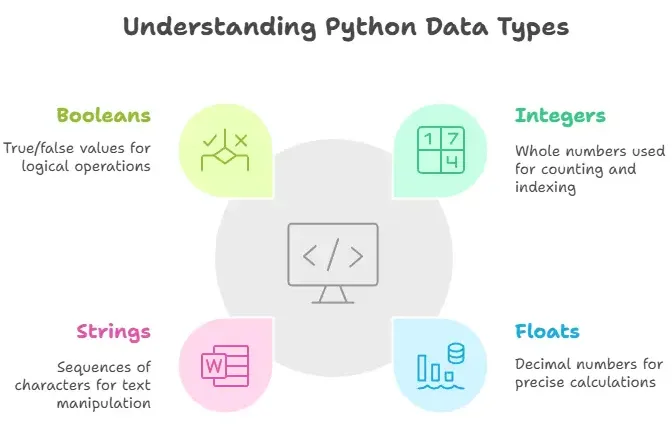Data Types in Python
Data types are fundamental building blocks in programming that define the type of data a variable can hold. Python supports various data types, each with its own characteristics and uses. In this topic, we'll explore Python's data types comprehensively, covering everything from basic types to more advanced ones.
Basic Data Types

Integers
Integers are whole numbers, positive or negative, without any decimal point.
# Example of integers
x = 10
y = -5
Boolean
The Boolean data type has two possible values: True and False. It is commonly used in conditional statements and logical operations.
# Assigning Boolean values
is_python_fun = True
is_sky_green = False
# Using Booleans in conditional statements
if is_python_fun:
print("Python is fun!")
else:
print("Python is not fun!")
# Boolean expressions
a = 10
b = 20
print(a > b) # False
print(a < b) # True
print(bool(0)) # False
print(bool(1)) # True
print(bool("")) # False (empty string)
print(bool("Hello")) # True (non-empty string)
Floats
Floats (floating-point numbers) are numbers with a decimal point or numbers in exponential form.
# Example of floats
pi = 3.14
temperature = 98.6
Strings
Strings are sequences of characters enclosed in single quotes (”) or double quotes (“”).
# Example of strings
name = "Alice"
message = 'Hello, Python!'
Sequence Data Types
Lists
Lists are ordered collections of items, which can be of different data types. They are mutable, meaning you can change their elements after they are created.
# Example of lists
my_list = [1, 2, 3, 'apple', 'banana']
Tuples
Tuples are similar to lists but are immutable, meaning you cannot change their elements after they are created.
# Example of tuples
my_tuple = (1, 2, 3, 'apple', 'banana')
Mapping Data Types
Dictionaries
Dictionaries are unordered collections of key-value pairs. They are mutable and can store elements of different data types.
# Example of dictionaries
my_dict = {'name': 'Alice', 'age': 30, 'city': 'New York'}
Set Data Types
Sets
Sets are unordered collections of unique elements. They do not allow duplicate elements.
# Example of sets
my_set = {1, 2, 3, 4, 5}
Understanding data types is crucial in Python programming as it allows you to work with different types of data efficiently. In this topic, we've covered the basic data types like integers, floats, and strings, as well as sequence types like lists and tuples, mapping types like dictionaries, and set types like sets. By mastering these data types, you'll be well-equipped to handle a wide range of programming tasks in Python. Happy Coding!❤️
